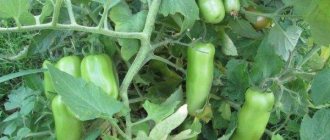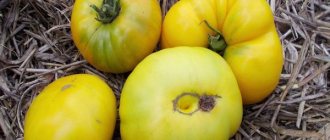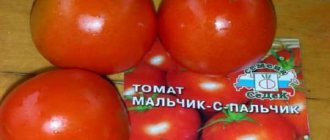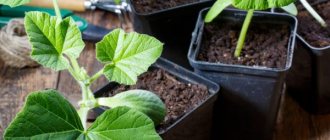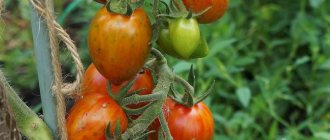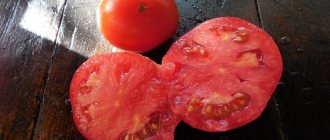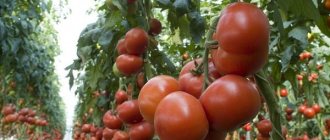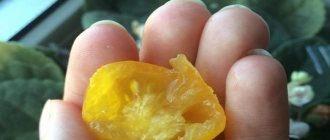Features of the variety
The Sahara tomato is a hybrid.
The variety can be found in different color variations:
- yellow;
- pink;
- red;
- brown.
Regardless of color, all fruits have a fleshy texture and a distinct sugary flavor. The vegetable is widely used in cooking not only for salads, but also soups, preparations, as well as snacks and sauces. The Sahara tomato was bred in 2009 and entered into the State Register in 2010.
Despite the fact that tomato fruits are fleshy, they tolerate transportation and storage well. The vegetable can also be grown both in a greenhouse and in the open air. The tomato tolerates low temperatures well and bears fruit until frost.
Useful video
In the table below you will find links to tomato varieties with different ripening periods:
| Mid-late | Early ripening | Late ripening |
| gold fish | Yamal | Premier |
| Raspberry miracle | Rose of Wind | Grapefruit |
| Miracle of the market | Diva | Bull's heart |
| De Barao Orange | Brawler | Bobcat |
| De Barao Red | Irina | King of Kings |
| Honey fireworks | Pink spam | Grandma's gift |
| Krasnobay F1 | Red Guard | Snowfall F1 |
Advantages and disadvantages
Tomato Sahara (the description of the variety and photo allows you to evaluate the vegetable before purchasing) has both pros and cons:
| Pros/Cons | Lists of facts |
| pros | · fruits are smooth, spherical and slightly flattened; · tomatoes can be used to prepare any dishes; · early ripening (90-120 days); · bushes and fruits do not die even in heat and low temperatures; · tomatoes have fairly thick skin, so they can be transported over fairly long distances; · the skin of the fruit does not crack during growth and during transportation; · bushes and fruits are resistant to most diseases; · the plant is not picky about the soil; · the fruits are quite large in size; · the pulp of the fruit is fleshy and contains few seeds; · If you follow the growing rules, you can reap a large harvest; · fruit pulp is hypoallergenic and contains a rich nutritional composition; · you can grow tomatoes of different colors; · Tomatoes can be planted outdoors and in a greenhouse; · the bush blooms and bears fruit before the onset of frost; · germination of seeds (purchased) lasts for approximately 10 years. |
| Minuses | · seeds from the grown crop are not suitable for planting, since the fruits are hybrid; · bushes need to be tied up so that the branches do not bend too much towards the ground. |
Consumers note that the fruits have a pronounced sugar taste. Some attribute this to the advantage of the variety, and others to the disadvantages.
Reviews
- Natalya from Voronezh. I planted a tomato with golden-green skin at the dacha last season. At first, the seedlings were covered with agrotex. In the second half of June I removed the greenhouse. I installed a trellis to which I tied tall varieties. Green tomato formed into 2 stems. By mid-July I picked the first tomato. It looked exactly like in the photo of the package with seeds. I really liked the taste and the aroma too.
- Valentina from Taganrog. I have been growing tomatoes for more than 20 years in the garden without shelter. Last year, a neighbor “treated” seedlings to varieties with green fruits. The new variety was carefully looked after. When the first tomato, which had previously been dark green, turned lighter, I did not dare to pick it for a long time. After removal and tasting, it turned out that the tomato was fully ripe. The sweet pulp tastes more like an exotic fruit.
- Dmitry from the Moscow region. In my greenhouse garden there are varieties of tomatoes of different colors. Among them is the presented tomato. I really like the variety. The fruits are large, juicy, good in salads. In addition to fresh consumption, they were sent for pickling in a barrel. Treated relatives and friends. Many were surprised by the sweet taste of green fruits.
A tomato called Green Sugar, like other similar varieties, successfully conquers a place in the garden. A tomato that looks unripe, but is actually very tasty, can quickly win the favor of an amateur gardener.
Characteristics of culture
Sahara tomato can be grown outdoors and in greenhouses. It should be borne in mind that greenhouse fruits are larger and ripen faster.
Ripening period
The ripening period of tomatoes depends on the climatic conditions under which they were grown, whether the rules for caring for the plant and fruit were followed, and whether the bushes were in a greenhouse or in the open air. When growing vegetables in open ground and in cool latitudes, harvesting can be done after 120 days. And in hot regions, or when grown in a greenhouse, the harvest can be harvested after about 90 days.
Drought resistance, frost resistance
Tomato Sahara (the description of the variety and photos of the fruit allow you to get acquainted with the main characteristics of the vegetable) tolerates any climatic conditions well. The bush does not wither, and the fruits do not fall off, both in the heat and when the temperature drops sharply. But if the thermometer drops closer to zero degrees, the bushes will stop blooming and gradually begin to fade. It is important that if the drought continues for a long time, the bushes need to be watered more often, otherwise they will wither.
Appearance of plant and fruit
Tomato bushes of the Sugar variety grown outdoors reach a height of about 1 m, and greenhouse ones can grow up to 1.4 m. The stems of the plant are dense, covered with a sufficient number of leaves that protect the fruits from the sun. Due to the fact that the stems are thick, they can easily support heavy fruits.
The Sahara tomato is a hybrid variety.
The tomatoes themselves have a slightly flattened, smooth, spherical shape with little ribbing. The fruits are fleshy, but dense, the pulp is juicy, aromatic and with a sweet taste. Tomatoes grow in clusters, about 4-5 pieces per cluster. A distinctive feature of the variety is the small number of chambers and seeds in the vegetable.
Productivity
With proper care of tomatoes and bushes, you can harvest about 7 kg from 1 square meter. In this case, the weight of one fruit can be in the range of 120-150 g. The frequency of tomato harvesting, under good climatic conditions, is approximately 2 times every 7 days. The bush stops bearing fruit after persistent frosts, so in hot climates you can reap a good harvest during the season.
Description of tomato variety Sugar brown
Brown Sugar tomato is a medium-late variety (some experienced gardeners consider it even late-ripening), indeterminate, tall. The stem is powerful, the bush has medium foliage. The leaf size is medium, the color is dark green. The first inflorescence is formed mainly under the 8th or 9th bush. Inflorescences of intermediate type. Greenhouse plants grow up to 2 m, in open ground the height reaches 1.5 m. The brush is simple, from 3 to 5 fruits are located on it.
Important! Due to the special chemical composition, the fruits of this tomato are considered dietary; even pediatricians recommend using them in baby food.
Description of fruits
The shape of the Sugar Brown tomato fruit varies between round and cuboid, and slight ribbing is noticeable. The peel is dense and smooth, so it does not crack. A fully ripened fruit has a brownish-brown color, its weight ranges between 140 and 150 g in the lower cluster, and slightly less in subsequent clusters. There are many seed chambers, which makes the Brown Sugar tomato fleshy, dense and with a small number of seeds. The flesh is bright, also brownish-red in color, becoming a little lighter in the middle. The taste is good, with a pleasant sweetness.
Features of planting and growing
The Sahara tomato grows well in any soil, but in order for the bush to bear fruit well and the vegetable to meet all the declared characteristics for this variety, all the planting and growing rules described below must be followed. For convenience, the information is accompanied by a photo.
Depending on where the tomato bushes grow (in a greenhouse or in the open air), the following will change: plant height, yield and fruit size. When growing tomatoes indoors, the yield is slightly higher than when ripening them in open ground.
Soil and planting algorithm
The soil for planting tomatoes needs to be prepared in the fall. After harvesting, all tops must be removed from the ground. Then the soil is carefully dug up, removing the roots of weeds, pests and their larvae. Finally, the soil is treated with disinfectants. In the spring, the soil needs to be dug up again to saturate it with oxygen, identify emerging insects with larvae, and remove grown weeds with roots.
After completing the procedures, the land is fertilized and disinfected from diseases and pests. After this, the soil should rest (1-2 weeks is enough) and be saturated with useful substances from fertilizers before planting seedlings.
To ensure that there are fewer pests and pathogens in the soil that tomatoes are susceptible to, once every 4 years, instead of tomatoes, the following should be planted on the site:
- legumes;
- onion;
- garlic;
- beets;
- carrot;
- cabbage
But you can’t plant potatoes and sweet peppers; on the contrary, they only increase the likelihood of the vegetable becoming infected. Sahara tomatoes are recommended to be planted as seedlings. Seeds must be started to be grown approximately 2-2.5 months before the expected planting date. For middle and hot latitudes, seed germination begins in March, and in cool regions the procedures are carried out around mid-April.
You must first prepare the soil for seed germination:
- Combine clean (without weed roots and larvae) soil in equal parts with humus (you can also use peat).
- Add 1 share of sawdust to the resulting mixture (you can take sand), they will ensure better saturation of the soil with oxygen.
- For disinfection, about 100-150 g of ash should be added to 10 kg of the resulting soil.
Seeds usually do not require preparation, as they are sold already disinfected. They need to be placed in prepared and well-moistened soil to a depth of approximately 1-2 cm. In this case, the soil must be distributed in advance into containers approximately 15 cm high (it is advisable to use degradable material so that the seedlings do not need to be pulled out of the trays when transplanted to the main place of growth ).
After the seeds are placed in the trays, the soil must be moistened and covered with film until sprouts appear. For lighting, which seedlings require from 12 to 16 hours per plant, it is recommended to use special lamps. Since the sun's rays can burn the seedlings. It is necessary to observe the temperature regime. The ambient temperature should be approximately 18-20 °C.
The first shoots should appear approximately in 7-10 days, after which the film is removed. During the growing process, you must not forget to irrigate it with warm water as the soil dries out (about once every 3-5 days). When 2-3 leaves are formed on the sprouts, the seedlings can be transplanted into the ground. The time for planting in the ground falls approximately in mid-May or the first half of June (depending on the climatic conditions of the region).
Young bushes should be planted in holes approximately 18-20 cm deep. Also, the distance between holes should preferably be 40x60 cm. Then the bushes will not interfere with each other’s growth and development.
Trimming
The Sahara tomato bushes grow quite branched, therefore, in order for the ovaries to form well and grow, it is recommended to remove excess shoots, leaving 2-3 stems. But it is not necessary to remove excess leaves from the bushes; they protect the fruits from direct sunlight.
Care
It is advisable to plant ready-made sprouts in open ground in a well-lit area. Further, during the growth process, the bushes need to be checked for the appearance of larvae and diseases. They should also be periodically fertilized and disinfected. And depending on weather conditions (prolonged heat or sudden cold snap), water the bushes with warm water or cover with a special protective cloth.
The first fertilization of seedlings is carried out approximately 7-10 days after planting. Then the procedure is repeated when active flowering begins, and then about 2 times during the fruiting period. Mature bushes need staking, otherwise their main stem may break from the weight of branches with fruits. The basis for the garter (strong sticks) must be installed in advance, during the process of planting seedlings, so as not to damage the already grown bushes later.
It is necessary to remove weeds from the soil once every 7 days, which can cause pests or fungus. They also “take away” a considerable part of the nutrients from the tomato, which gradually leads to a decrease in yield.
Diseases and pests
Tomato Sahara, the variety description and photo of which are presented in the article, are considered protected from diseases and pests.
But in order to completely eliminate the possibility of infection, damage to fruits and plants, preventive measures should be taken against pests:
| Lists of pests | Description of signs of damage | Ways to fight |
| Aphid | Depending on the species, aphids can attack the above-ground and underground parts of the plant. As a result, the bush does not receive the required amount of water and nutrients, and begins to actively wither. | To destroy the pest, if it has just appeared, it is enough to thoroughly water each bush with a stream of water to wash away the insects and their larvae. If tomatoes grow in a greenhouse, then ladybugs can be bred in it, which feed on this insect. You can also spray the bushes with a solution of ammonia, soap or garlic. If the pest has attacked in large numbers, then the following products are recommended for its destruction: Iskra, Aktaru, Fitoverm, as well as bleach. |
| Ticks | The appearance of a mite can be determined by the fading leaves, the “stunted” appearance of the bush itself and a sharp decrease in yield. Insects can form a kind of cobweb on the plant. | It is recommended to treat the bushes with solutions of soap, with onion peels or garlic; an alcohol solution with ammonia or shag is also suitable. Mites do not like high humidity, so when growing tomatoes in a greenhouse, you should create conditions for high humidity, but without harm to the plant itself. Combining the process with the removal of affected leaves from the bushes. If the listed methods do not help, then you can use the following drugs: Fufanon, Fitoverm or Sunmite. |
| Slugs | Slugs eat not only the leaves and stems of the bush, they also like to feast on ripe fruits. The pest can be quickly identified by eaten parts of the plant and rotting tomatoes. | It is considered most effective to collect slugs by hand; the process is labor-intensive, but safe. You can use special nematodes that do not harm the tomato, but at the same time repel the pest. You can treat bushes with solutions with strong odors (with ammonia, onions, garlic). You can use traps with cornmeal, which kills the slugs when they eat it. If there is no effect, use the following remedies: “Slug eater, Thunderstorm or 1% solution of copper sulfate. |
| Fungi | When a bush is infected with a fungus, the leaves begin to wither and the fruits themselves rot. If no measures are taken, the plant quickly dies. Important. Tomatoes removed from an affected bush, even without signs of spoilage, are contaminated and cannot be stored with a “healthy” harvest. | To prevent the development of fungus, it is necessary to properly treat the seeds and soil before planting. If a fungus is detected, it is recommended not only to uproot all affected plants, but also to immediately burn them so that the pathogen is completely destroyed. When the fungus has just begun to develop on the plant, the bush and fruits must be immediately treated with solutions: Bordeaux mixture, Polychome, Barrier. Important. After harvesting, it is necessary to thoroughly treat the soil and greenhouse (if the tomatoes were grown indoors). And burn all the bushes, even those without signs of damage. |
| Armyworm and Colorado potato beetle larvae | In pests, it is not the adults that are dangerous, but their larvae, which eat the ground and root parts of the plant and can also spoil the fruits. Bushes affected by the pest quickly wither and die. | The pest and its larvae can be destroyed by treating the bushes with a solution of garlic arrows, onion peels or a decoction of wormwood. It is recommended to manually collect adults and larvae and drown them in kerosene. Marigolds, mustard grass or garlic should be planted between the bushes. If there is no effect from the measures described above, you can use the following drugs: Inta-Vir, Arrivo. The most important protection is to check the bushes daily for the appearance of adult pests before they lay larvae. |
| Wireworm and mole cricket | Pests destroy mainly the underground part of the tomato. As a result, the plant does not receive nutrients in the required quantities, and begins to wither, and fruit ovaries cease to form. | Initially, you should thoroughly dig up the soil before planting, since animal larvae live in the soil. During the digging process, they should be removed from the ground and immediately destroyed. The land needs to be treated, before planting and during the process of fruit ripening, with Force, Medvetoks, Thunder. In addition, you can set traps for pests. For example, pour oil into a jar and add honey. Bury the jars themselves next to the bushes up to the neck. Mole cricket larvae and adults will get into the jars, but will not be able to get out of them. And the wireworm is easily found on potato pieces, which should be changed periodically. |
| Root nematode | A small insect (no more than 1.5 mm long) destroys the root system of bushes. As a result, the plant begins to lean and may completely fall. And as a result of the weakening of the root system, tomatoes are quickly affected by fungal diseases. | To eliminate the parasite, you should grow garlic, onions or cabbage next to the tomatoes. They repel the pest. You can also periodically water the soil with boiling water and immediately cover it with film; the insects will crawl to the surface and die. You can use bleach, Fitoverm. The best method to prevent insect infestation of tomatoes is thorough disinfection of equipment, as well as high-quality soil preparation. You need to inspect the bushes daily for signs of damage. |
The soil for planting seedlings should be replaced regularly (preferably every autumn). In this case, the new soil must be immediately thoroughly soaked in a hot solution with potassium permanganate.
Wintering
Since tomatoes tolerate frost well and can bear fruit constantly, they can be grown in winter. But for this it is necessary that the plant grows in a special greenhouse with heating and lighting. From time to time it is necessary to replace bushes (which begin to produce little yield) with young seedlings.
Harvesting
The first harvest (especially in hot regions) can begin to be harvested after July 20 (in cool climates, tomatoes ripen only in August). When picking tomatoes, you should take into account that you need to remove them from the bushes carefully so as not to damage the branches, since ovaries may form on them again later. During the picking process, you should not drop the fruits, but carefully place them in containers, otherwise the tomatoes will begin to rot.
The last harvest of tomatoes occurs at the beginning of frost, so the fruits can be picked green, they ripen well at home in the warmth, and for this the tomatoes do not require additional light, the main thing is that the air temperature is about 25 ° C and not too much humidity.
Storage
The harvested crop should be checked for signs of deformation and damaged areas. If there are defective tomatoes, then they are used first, and even, dense and without flaws are suitable for storage. Moreover, the fruits should be stored in ventilated wooden boxes at a temperature of about 2-5 °C. There should be no strong humidity in the room. During storage, the crop should be periodically checked for safety.
Product Technical Data
Agronomists have developed tomatoes for greenhouses and temporary shelters. Description of the variety:
- indeterminate, stretches up to 1.5 m;
- average ripening period (interval from loops to fruit tasting) What berries
Gardeners are interested in the taste and characteristics of the variety. Characteristics of tomatoes:
- average fruit size (How to achieve results without losses
The taste of tomatoes depends on growing conditions. Illumination, temperature, soil and air humidity change it. To make the berries sweeter, you should follow the recommendations of agrobiologists:
- start seedlings in the first ten days of March;
- after pecking the loops, place the tray on a bright, cool windowsill;
- increase daylight hours to 16 hours;
- two true leaves - a signal for picking with penetration to the cotyledons;
- seedlings need hardening and ventilation;
- do not allow the soil to become waterlogged;
- applying fertilizer complexes for seedlings will strengthen the plants;
- should be placed in unheated greenhouses after spring frosts;
- it is necessary to shade the Sugar tomato from the sun on the first day;
- do not allow the air in the greenhouse to overheat: pollen is sterilized;
- provide drip irrigation;
- lighten the plants weekly, pruning, tying up;
- ventilation will maintain optimal air humidity;
- treat with insecticides against pests.
Tomatoes should be formed into 2 stems. This will allow you to get the largest possible fruits. Red sugar is included in the State Register of Vegetable Crops of the Russian Federation. The creators recommend planting tomatoes in private gardens and personal plots.
Growing regions
Tomato Sahara (the description of the variety and photos of the fruits prove the unpretentiousness of the vegetable to the growing region) can be planted in the open air or in a greenhouse. Thanks to the unpretentiousness of the bushes, the vegetable can be grown in any climate zone.
But it should be borne in mind that in cool regions it is better to place plants in greenhouses, and where there is constant heat, the bushes must be regularly watered.
Diseases and pests
The State Register and Agro do not write anything about the resistance of tomatoes to diseases. Reviews from gardeners so far indicate only a tendency towards blossom end rot - this is typical for all beefs.
Considering that it takes at least 120 days for the fruit to ripen, the result is good. Late tomatoes usually “collect” all the diseases of the crop.
When planting Sugar Nastasya in the garden, we must not forget about crop rotation, and in greenhouses the soil should be improved annually. The soil and bushes are populated with Trichoderma and (or) Bacillus subtilis, and preventive treatments are done.
Proper agricultural technology contributes to the proper development and increase of plant immunity.
Where to buy, how much it costs
You can buy Sahara tomato seeds in a special store, or order them online. Despite the fact that prices are lower in online stores, there is a high probability of purchasing fake or expired seeds. Therefore, if possible, you should purchase packets of seeds from trusted outlets. The average cost for 10 seeds in a pack is about 80 rubles, and for 100 seeds in a pack you will have to pay about 300 rubles.
In specialized stores you can buy ready-made tomato seedlings. At the same time, you need to be confident in the seller that he is selling the really desired variety of tomato, and that they are free from pests or diseases. The price for seedlings can reach (for 1 bush) 150 rubles.
Gardeners and chefs liked the Sahara tomato for its bright sugar taste and soft texture. The vegetable, according to the description of its cultivation, is not picky about the soil and is unpretentious in care. And thanks to the bright color, which can be appreciated in the photo, which can be from yellow to brown, the variety attracts buyers even more.
Specifics of purchasing seed material
The tomato is very good, but negative reviews from gardeners about it are quite common. This is not surprising: in most cases, tomatoes of the wrong variety grow from seed purchased at official retail outlets.
The characteristics of the “Sugar Giant” tomato and the photos posted on the seed packages are amazingly diverse. For example, “Russian Garden” describes the shape of the fruit as “cuboidal,” which does not prevent “Russian Garden” from displaying images of heart-shaped tomatoes on some of the bags. On the packaging of the Ural Summer Resident brand there are photos of flat-round tomatoes. At the same time, the variety itself is characterized as mid-season. Less known, it positions the tomato as a mid-early one, with round fruits weighing up to 1 kg (in the photo the tomatoes are flat-round, with strong ribbing).
The confusion is aggravated by the fact that seeds of the variety are available for sale, packaged in Ukraine. These plants, most likely, are not intended for cultivation at all in most climatic zones of Russia.
As you can see, packages of seeds of the same variety from different manufacturers show tomatoes of different shapes
According to reviews, “Sugar Giant” tomatoes grown from “purchased” seeds often correspond to the descriptions of officially recognized varieties. For example, “Giant”, “Sugar Bison” or “Sugar Giant”. Sometimes such bags contain material of unknown origin and the lowest quality.
The highest guarantee of obtaining plants of the desired variety is provided by purchasing seeds from amateur tomato growers or from private nurseries with a good reputation.
